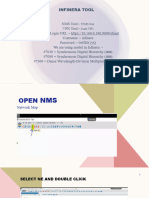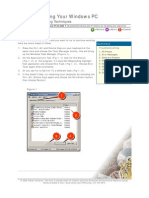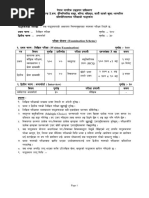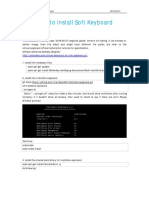OTN
OTN
Uploaded by
Matt Rod ParraCopyright:
Available Formats
OTN
OTN
Uploaded by
Matt Rod ParraCopyright
Available Formats
Share this document
Did you find this document useful?
Is this content inappropriate?
Copyright:
Available Formats
OTN
OTN
Uploaded by
Matt Rod ParraCopyright:
Available Formats
THE G.
709 OPTICAL TRANSPORT NETWORK AN OVERVIEW
153
APPLICATION NOTE
Robert Gendron, System Engineer, Transport and Datacom Business Unit Amato Gidaro, Product Manager, Transport and Datacom Business Unit
The optical transport network (OTN) was created with the intention of combining the benefits of SONET/SDH technology with the bandwidth expansion capabilities offered by dense wavelength-division multiplexing (DWDM) technology. In addition to further enhancing the support for operations, administration, maintenance and provisioning (OAM&P) functions of SONET/SDH in DWDM networks, the purpose of the ITU G.709 standard (based on ITU G.872) is threefold. First, it defines the optical transport hierarchy of the OTN; second, it defines the functionality of its overhead in support of multiwavelength optical networks; and third, it defines its frame structures, bit rates and formats for mapping client signals. In order to begin describing the OTN as defined by the ITU G.709 standard, we must first enumerate its critical elements, their termination points, and the way they relate to one another in terms of hierarchy and function. In essence, the OTN consists of the following parts, which are often referred to as layers: Optical Transport Section (OTS) Optical Multiplex Section (OMS) Optical Channel (OCh) Optical Transport Unit (OTU) Optical Data Unit (ODU) Optical Channel Payload Unit (OPU) Each of these elements and their functions are distributed along the network and activated when they reach their termination points, which are illustrated in Figure 1 below.
T OTS
A OTS OMS OCh OTU
3R OTS OMS OCh OTU ODU OPU Client signal
3R OTS
A OTS OMS OCh OTU
T
T = Client access point A = Optical amplifier 3R = Regeneration, reshape, re-time
Figure 1: OTN Layer Termination Points
www.EXFO.com
Telecom Test and Measurement
Application Note 153
The termination of the OTS, OMS and OCh layers is performed at the optical level of the OTN. It is at the termination of the OTU layer that further functionality can be added. This layer is the digital layeralso known as the digital wrapper and offers specific overhead to manage the OTNs digital functions. The OTU also introduces a new dimension to optical networking by adding forward error correction (FEC) to the network elements, allowing operators to limit the number of required regenerators used in the network which, in turn, lowers its cost. FEC allows an increase in the optical link budget by providing a method to correct errors, thereby reducing the impact of network noise and other optical phenomena experienced by the client signal traveling through the network. As shown in Figure 1, the OTU also encapsulates two additional layersthe ODU and the OPUwhich provide access to the payload (SONET, SDH, etc.). These layers are normally terminated at the same location. The OTU, ODU (including the ODU tandem connection monitoring) and OPU layers can all be analyzed and monitored. As per ITU G.709, the three line rates below are offered, test solutions are currently offered for OTU1 and OTU2: OTU1 (255/238 x 2.488 320 Gb/s 2.666057143 Gb/s) also referred to as 2.7 Gb/s OTU2 (255/237 x 9.953280 Gb/s 10.709225316 Gb/s) also referred to as 10.7 Gb/s OTU3 (255/236 x 39.813120 Gb/s 43.018413559 Gb/s) also referred to as 43 Gb/s Each line rate is adapted to service different client signals: OC-48/STM-16 is transported via OTU1 OC-192/STM-64 is transported via OTU2 OC-768/STM-256 is transported via OTU3 Null Client (All 0s) is transported via OTUk (k = 1, 2, 3) PRBS 231-1 is transported via OTUk (k = 1, 2, 3) In order to map client signals via ITU G.709, they are encapsulated using the structure illustrated in Figure 2.
SONET, SDH, Null, PRBS, ... Encapsulation Decapsulation Client signal OPU OH ODU OH ODU TCM OH OTU OH OCh OH OMS OH OTS OH OSC
Figure 2: Basic OTN Transport Structure
Client OPU ODU
1-6 level
Client signal OPU ODU
ODU TCM OTU
ODU (including TCM)
FEC
OCh
OCh OMS OTS
OCh
OCh
OCh OMS OTS
www.EXFO.com
Telecom Test and Measurement
Application Note 153
As depicted above, to create an OTU frame, a client signal rate is first adapted at the OPU layer. The adaptation consists of adjusting the client signal rate to the OPU rate. Its overhead contains information to support the adaptation of the client signal. Once adapted, the OPU is mapped into the ODU. The ODU maps the OPU and adds the overhead necessary to ensure end-to-end supervision and tandem connection monitoring (up to six levels). Finally, the ODU is mapped into an OTU, which provides framing as well as section monitoring and FEC. Following the OTN structure presented in Figure 2, OTUks (k = 1, 2, 3) are transported using the OCh; each channel is assigned a specific wavelength of the ITU grid. Several channels can be mapped into the OMS and then transported via the OTS layer. The OCh, OMS and OTS layers each have their own overhead for management purposes at the optical level. The overhead of these optical layers is transported outside of the ITU grid in an out-of-band channel called the optical supervisory channel (OSC). When the OTU frame structure is complete (OPU, ODU and OTU), ITU G.709 provides OAM&P functions that are supported by the overhead.
OTU Frame Structure and Overhead
As shown in the figure below, the OTU frame is broken down into the following components: Framing OTU, ODU, OPU overhead TCM OTU FEC
0 .. . 15 16 .. 31 32 .. .. 63
SAPI DAPI Operator Specific 6 7 8 9 10 11 12 13 14 GCCO RES SM MFAS 1................................................................................14.15. 16. 17.......................................................................................................................3824. 3825.........................................4080 OTU OH FAS OH OPU OH ODU OH OPU Payload (Client Signal) OTU FEC (4 x 256 bytes)
BEI/BIAE
TTI
Byte 10
1 2 3 4 5 FAS
OTU Frame
1 2 3 4
15
FTFL
16 Mapping
2 3 4
RES TCM3
GCC1
TCM ACT
TCM6
APS/PCC
TCM5 TCM1
TCM4 PM
RES
GCC1
1 2 3 4 5 6 7 8 9 10 11 12 13 14
PM and TCMi (i= 1 to 6)
PSI
1 TTI
0 . .. 15 16 . . 31 32 .. . . 63
2 BIP-8 1
BDI
SAPI DAPI
PM
2 3 4 5 6 7 8 BEI STAT
Byte 3
Forward
0........1...............................................9. 10.....................................127 Operator Operator FIF Specific Identifier 128...129.........................................137. 138................................255 Operator Operator FIF Identifier Specific FIF = Fault Identification Field FTFL
Figure 3: OTU Frame Description
www.EXFO.com
Telecom Test and Measurement
BDI
Operator Specific
TCMi
2 3 4 5 6 7 8 BEI/BIAE STAT
Backward
Mapping
TCM2
EXP
1 2 3 4
0 1 ... ... .. ... .. ... .. . 255
PT
BDI IAE
8 TTI
9 BIP-8
10
1 2 3 4
5 6
7 8 RES
Application Note 153
Framing The OTU framing is divided into two portions: FAS and MFAS. The frame alignment signal (FAS) uses the first six bytes and, similarly to SONET/SDH, it is used to provide framing for the entire signal. In order to provide enough 1/0 transitions for synchronization, scrambling is used over the entire OTU frame, except for the FAS bytes. The multiframe alignment signal (MFAS) byte is used to extend command and management functions over several frames. The MFAS counts from 0 to 255, providing a 256 multiframe structure. Overhead Each portion of the OTU frame has its own specific overhead functions. They are displayed in Figure 3 and are briefly described below. Further details can be found about these overhead fields in the ITU G.709 standard. Optical Transport Unit (OTU) The OTU overhead is comprised of the SM, GCC0 and RES bytes. The section monitoring (SM) bytes are used for the trail trace identifier (TTI), parity (BIP-8) and the backward error indicator (BEI), or backward incoming alignment error (BIAE), backward defect indicator (BDI), and incoming alignment error (IAE). The TTI is distributed over the multiframe and is 64 bytes in length. It is repeated four times over the multiframe. General communication channel 0 (GCC0) is a clear channel used for transmission of information between OTU termination points. The reserved (RES) bytes are currently undefined in the standard. Optical Data Unit (ODU) The ODU overhead is broken into several fields: RES, PM, TCMi, TCM ACT, FTFL, EXP, GCC1/GCC2 and APS/PCC. The reserved (RES) bytes are undefined and are set aside for future applications. The path monitoring (PM) field is similar to the SM field described above. It contains the TTI, BIP-8, BEI, BDI and Status (STAT) sub-fields. There are six tandem connection monitoring (TCMi) fields that define the ODU TCM sub-layer, each containing TTI, BIP-8, BEI/BIAE, BDI and STAT sub-fields associated to each TCM level (i=1 to 6). The STAT sub-field is used in the PM and TCMi fields to provide an indication of the presence or absence of maintenance signals. The tandem connection monitoring activation/deactivation (TCM ACT) field is currently undefined in the standards. The fault type and fault location reporting communication channel (FTFL) field is used to create a message spread over a 256-byte multiframe. It provides the ability to send forward and backward path-level fault indications. The experimental (EXP) field is a field that is not subject to standards and is available for network operator applications. General communication channels 1 and 2 (GCC1/GCC2) fields are very similar to the GCC0 field except that each channel is available in the ODU. The automatic protection switching and protection communication channel (APS/PCC) supports up to eight levels of nested APS/PCC signals, which are associated to a dedicated-connection monitoring level depending on the value of the multiframe. Optical Payload Unit (OPU) The primary overhead field associated with the OPU is the payload structure identifier (PSI). This is a 256-byte multiframe whose first byte is defined as the payload type (PT). The remaining 255 bytes are currently reserved. The other fields in the OPU overhead are dependent on the mapping capabilities associated to the OPU. For an asynchronous mapping (the client signal and OPU clock are different) justification control (JC) bytes are available to
www.EXFO.com
Telecom Test and Measurement
Application Note 153
compensate for clock rate differences. For a purely synchronous mapping (client source and OPU clock are the same), the JC bytes become reserved. Further details on mapping are available in ITU G.709. Tandem Connection Monitoring (TCM) TCM enables the user and its signal carriers to monitor the quality of the traffic that is transported between segments or connections in the network. SONET/SDH allowed a single level of TCM to be configured, while ITU G.709 allows six levels of tandem connection monitoring to be configured. The assignment of monitored connections is currently a manual process that involves an understanding between the different parties. There are various types of monitored connection topologies: cascaded, nested and overlapping. Examples of these topologies are provided in Figure 4.
Carrier A (A1 - A2) Carrier B (B1 - B2) User Traffic Carrier C (C1 - C2) Carrier B (B3 - B4) User Traffic
ODU TCM6 TCM5 TCM4 TCM3 TCM2 PM TCM1 TCM6 TCM5 TCM4 TCM3 TCM2 TCM1 TCM6 TCM5 TCM4 TCM3 TCM2 TCM1 TCM6 TCM5 TCM4 TCM3 TCM2 TCM1 TCM6 TCM5 TCM4 TCM3 TCM2 TCM1 TCM6 TCM5 TCM4 TCM3 TCM2 TCM1 TCM6 TCM5 TCM4 TCM3 TCM2 TCM1
ODU
PM
Connection Topologies
Cascaded
Nested
Overlapping
Figure 4: Tandem Connection Monitoring
Each of the six TCMi fields in the ODU overhead is assigned to a monitored connection. There can be from zero to six levels or connections that can be configured for each ODU trail. In the Figure 4 example, there are three different levels that are actually monitored. Carrier C, due to its location, can monitor three TCM levels as the ODU passes through its portion of the network. The other carriers also monitor the levels according to agreement and location. In addition to monitoring maintenance signals, using the STAT sub-field associated with each TCM level, the TCM connection also monitors the BIP-8 and BEI errors for each connection level. Maintenance signals are used to advertise upstream maintenance conditions affecting the traffic; errors, on the other hand, provide an indication of the quality of service offered at each segment of the network, which delivers a valuable tool for the user and carrier to isolate faulty sections of the network.
www.EXFO.com
Telecom Test and Measurement
Application Note 153
Forward Error Correction (FEC) The ITU G.709 standard supports forward error correction (FEC) in the OTU frame and is the last part added to the frame before the frame is scrambled. FEC provides a method to significantly reduce the number of transmitted errors due to noise, as well as other optical phenomena that occur at high transmission speeds. This enables providers to support longer spans in between optical repeaters. An OTU frame is divided into four rows. Each row is broken down into 16 sub-rows comprised of 255 bytes each, as shown in Figure 5. A sub-row is composed of interleaved bytes. The interleave is executed so that the first sub-row contains the first overhead (OH) byte, the first payload byte and the first FEC byte, and so on for the remaining sub-rows of each row in the frame. The first FEC byte starts at position 240 for all sub-rows. The FEC uses a Reed-Solomon RS (255/239) coding technique. This means that 239 bytes are required to compute a 16-byte parity check. The FEC can correct up to eight (bytes) errors per sub-row (codeword) or detect up to 16 byte errors without correcting any. Combined with the byte interleave capability included in ITU G.709 implementation, the FEC is more resilient to error burst, where up to 128 consecutive bytes can be corrected per OTU frame row.
Row 1 .
OTU Frame
. . . . . . . . . . . . . .
1..............................................................................................14. 15. 16. 17.........................................................................3824. 3825.......................4080 OTU OH FAS OH 1 2 OPU Payload OTU FEC (Client Signal) (4 x 256 bytes) 3 ODU OH 4 1.......................................................................................14. 15. 16. 17.........................33........................................3824. 3825........................4080
Row 1
OPU OH
Sub-Row 1
(codeword)
OTU Sub-Rows
1 1 2 3 4 5 6 7 8 9 10 11 12 13 14 15 16
Sub-Row 2
(codeword)
Sub-Row 3
(codeword) OH Payload Bytes FEC
OTU Rows
2 3 4
1...........................................239. 240...............255
OH
Payload Bytes
FEC
Figure 5: Forward Error Correction
Conclusion
It is expected that the G.709-based OTN will greatly improve administration, maintenance and provisioning operations on DWDM networks and ultimately provide superior transmission. Of course, as with every type of network, testing always ensures optimum performance. Among the aspects that should be tested in order for OTN equipment to comply with ITU G.709 and ITU G.798 are the following:
www.EXFO.com
Telecom Test and Measurement
Application Note 153
Interface specifications The interface specification tests consist in determining that the appropriate OTUk rates are supported and that synchronization recovery can be properly achieved by the DUT. Additional tests like optical-power sensitivity can also be achieved using external equipment (optical attenuator). Response of the device under test (DUT) The DUT response test allows the user to use a stimulus (error or alarm) and detect from the test equipment that a DUT is responding with the proper consequential actions for the injected errors or alarm. ITU conformance and interoperability ITU conformance and interoperability relates to the ability to determine that the DUT is able to detect various events under the correct stimulus and standard specified period of time. Mapping/demapping of client signals The mapping/demapping of client signals enable the test equipment to determine if the DUT correctly recovers the OPU payload under the synchronous and asynchronous mapping specifications in terms of required frequency offset tolerance. Appropriate FEC behavior In order to determine the appropriate FEC behavior of a DUT, the test equipment generates correctable or uncorrectable FEC errors and determines if traffic errors are detected. In a basic test, correctable or uncorrectable FEC errors are distributed over the FEC portion of the frame. This facilitates the discovery of unexpected behavior without affecting the traffic, thus building a confidence level in the FEC under test. As the risk is reduced, additional FEC stress tests can be conducted on the signal by distributing, at random and over the entire OTU frame, correctable errors that should be recovered by the DUT. This time, if the DUT is unable to correct errors, the payload will be affected. The ITU G.709 testing standard is supported by the EXFO FTB-8120/FTB-8130 or IQS-8120/IQS-8130 modules. For further insight on their ITU G.709 testing capabilities we invite you to consult their respective specification sheets. In the meantime, we hope this application note succeeded in providing a broad description of the optical transport network and the standards governing it.
References [1] ITU Recommendation G.709/Y.1331, Interfaces for the Optical Transport Network (OTN), March 2003 (Amendment1 December 2003) [2] ITU Recommendation G.798, Characteristics of optical transport network hierarchy equipment functional blocks, June 2004 (Erratum 1 May 2005) [3] ITU Recommendation G.872, Architecture of optical transport networks, November 2001 (Amendment1 December 2003, Corrigendum 1 January 2005)
EXFO Corporate Headquarters > 400 Godin Avenue, Quebec City (Quebec) G1M 2K2 CANADA Tel.: 1 418 683-0211 Fax: 1 418 683-2170 info@EXFO.com Toll-free: 1 800 663-3936 (USA and Canada) www.EXFO.com
EXFO Montreal EXFO Toronto EXFO America EXFO Europe EXFO Asia EXFO China 2650 Marie-Curie 160 Drumlin Circle 3701 Plano Parkway, Suite 160 Omega Enterprise Park, Electron Way 151 Chin Swee Road, #03-29 Manhattan House No.88 Fuhua, First Road Central Tower, Room 801, Futian District Beijing New Century Hotel Office Tower, Room 1754-1755 No. 6 Southern Capital Gym Road St-Laurent (Quebec) H4S 2C3 CANADA Concord (Ontario) L4K 3E5 CANADA Plano, TX 75075 USA Chandlers Ford, Hampshire S053 4SE ENGLAND SINGAPORE 169876 Shenzhen 518048, CHINA Beijing 100044 P. R. CHINA Tel.: 1 514 856-2222 Tel.: 1 905 738-3741 Tel.: 1 800 663-3936 Tel.: +44 2380 246810 Tel.: +65 6333 8241 Tel.: +86 (755) 8203 2300 Tel.: +86 (10) 6849 2738 Fax: 1 514 856-2232 Fax: 1 905 738-3712 Fax: 1 972 836-0164 Fax: +44 2380 246801 Fax: +65 6333 8242 Fax: +86 (755) 8203 2306 Fax: +86 (10) 6849 2662
Appnote153.1AN
2006 EXFO Electro-Optical Engineering Inc. All rights reserved.
Printed in Canada 06/09
You might also like
- Unit:4 Iot Applications For Value CreationsDocument45 pagesUnit:4 Iot Applications For Value CreationsVishal Joshi100% (4)
- Optical Transport Network (OTN) - A Comprehensive Study - MapYourTechDocument45 pagesOptical Transport Network (OTN) - A Comprehensive Study - MapYourTechJesus RosalesNo ratings yet
- Infinera IEEE OTN OverviewDocument25 pagesInfinera IEEE OTN OverviewTaha Ben AmorNo ratings yet
- 207.OTN 260SCX2 and 130SCX10 Cards V1 04 11feb16Document24 pages207.OTN 260SCX2 and 130SCX10 Cards V1 04 11feb16Ronald N Meza C100% (1)
- Otn FrameDocument22 pagesOtn FrameWubie NegaNo ratings yet
- Optical Transport NetworkDocument28 pagesOptical Transport NetworkshawnNo ratings yet
- Optical Transport Networks Training OTN TrainingDocument8 pagesOptical Transport Networks Training OTN TrainingmexybabyNo ratings yet
- OTC000005 OTN Introduction Issue1.04 PDFDocument70 pagesOTC000005 OTN Introduction Issue1.04 PDFchineaNo ratings yet
- Understanding Itu G709 Standard For Optical NetworksDocument60 pagesUnderstanding Itu G709 Standard For Optical NetworksFida Mohammad100% (1)
- LTE Self-Organising Networks (SON): Network Management Automation for Operational EfficiencyFrom EverandLTE Self-Organising Networks (SON): Network Management Automation for Operational EfficiencySeppo HämäläinenNo ratings yet
- Optical Transport Network (OTN)Document40 pagesOptical Transport Network (OTN)MaheshNo ratings yet
- OTNDocument22 pagesOTNAjay BarwalNo ratings yet
- ECC Link Setup Failure Due To High Optical PowerDocument3 pagesECC Link Setup Failure Due To High Optical PowerSery ArthurNo ratings yet
- Troubleshooting Alarm HandlingDocument57 pagesTroubleshooting Alarm HandlingMehdiNo ratings yet
- Concept of ASONDocument52 pagesConcept of ASONMuhammad Bilal KhattakNo ratings yet
- 6-NG WDM Hardware Description V4 (1) .0-20081030-ADocument159 pages6-NG WDM Hardware Description V4 (1) .0-20081030-AHanh LeNo ratings yet
- Huawei OptiX OSN 8800 Optical Transponder Board L4G Hardware Description PDFDocument28 pagesHuawei OptiX OSN 8800 Optical Transponder Board L4G Hardware Description PDFThunder-Link.comNo ratings yet
- Script On Optical Network Communication BasicsDocument16 pagesScript On Optical Network Communication Basicsfatemeh sameniNo ratings yet
- Nokia Pre - 4A0-205 40q-DEMODocument15 pagesNokia Pre - 4A0-205 40q-DEMOMartin KafulaNo ratings yet
- Opti BWS 1600G Optical Power CalculationDocument33 pagesOpti BWS 1600G Optical Power CalculationM Tanvir AnwarNo ratings yet
- ZTE TarjetasDocument18 pagesZTE TarjetasgermanramierezNo ratings yet
- OTC000005 OTN Introduction ISSUE1.00Document73 pagesOTC000005 OTN Introduction ISSUE1.00Mohammed Kumayl100% (1)
- Infinera SOPDocument34 pagesInfinera SOPDagoberto RojanoNo ratings yet
- NMSforCS 1Document28 pagesNMSforCS 1Gova Reddy100% (2)
- A Presentation On An Industrial Training Taken at CTTC-Kolkata (BSNL)Document26 pagesA Presentation On An Industrial Training Taken at CTTC-Kolkata (BSNL)Tajinder SinghNo ratings yet
- OptiX OSN 6800 Hardware Description ISSUEDocument160 pagesOptiX OSN 6800 Hardware Description ISSUEOscar Leon Iriarte100% (1)
- OSN 9800 M24: Huawei Enterprise Backbone OTN EquipmentDocument6 pagesOSN 9800 M24: Huawei Enterprise Backbone OTN EquipmentdonekeoNo ratings yet
- 2 PDF Hardware DescriptionDocument51 pages2 PDF Hardware DescriptionI'MOTOTAHANo ratings yet
- Procedure For Tunnel Creation in NPTDocument6 pagesProcedure For Tunnel Creation in NPTVenkatesh t.k100% (1)
- DWDM Viva QuestionDocument31 pagesDWDM Viva QuestionUpendra Reddy50% (2)
- Infinera-Tunable Colorless Network Nodes-MorkelDocument7 pagesInfinera-Tunable Colorless Network Nodes-Morkelsrotenstein3114No ratings yet
- Nokia 4A0 230 Exam Practice Questions Document enDocument4 pagesNokia 4A0 230 Exam Practice Questions Document enNo Bi TaNo ratings yet
- What Och OduDocument12 pagesWhat Och OduxiwayNo ratings yet
- Department of Electronics and Telecommunication: Pillai College of Engineering New Panvel - 410 206Document16 pagesDepartment of Electronics and Telecommunication: Pillai College of Engineering New Panvel - 410 206Venkatraman SubramanianNo ratings yet
- Ason v1 2 PDFDocument1 pageAson v1 2 PDFGiorgio Valtolina100% (1)
- An Operator's View On Introduction of White Boxes in Optical NetworksDocument10 pagesAn Operator's View On Introduction of White Boxes in Optical Networksmcclaink06No ratings yet
- DWDM Optical Power DebuggingDocument17 pagesDWDM Optical Power DebuggingJuancarlos ArrietaNo ratings yet
- Webinar 3 - MPLS Inroduction Part 2Document76 pagesWebinar 3 - MPLS Inroduction Part 2Jaime Garcia De ParedesNo ratings yet
- SDH Trail CreationDocument7 pagesSDH Trail CreationFelix GatambiaNo ratings yet
- Things To Know On Coherent TechnologyDocument11 pagesThings To Know On Coherent TechnologySanjay Yadav0% (1)
- Ciena O562x 6500 First Line MaintenanceDocument20 pagesCiena O562x 6500 First Line MaintenanceSery ArthurNo ratings yet
- 7090 CE Packet Transport Solutions: Intelligent Carrier Ethernet Platforms For Next-Generation NetworksDocument5 pages7090 CE Packet Transport Solutions: Intelligent Carrier Ethernet Platforms For Next-Generation NetworksChahyadi Awan HandayantoNo ratings yet
- Telecom Basics For BUGSDocument37 pagesTelecom Basics For BUGSGurpreet SinghNo ratings yet
- OTN Ciena DataDocument3 pagesOTN Ciena DatafonpereiraNo ratings yet
- 1830 PSS GMRE Control PlaneDocument17 pages1830 PSS GMRE Control PlaneImisebe TelecomsNo ratings yet
- GPONDocument8 pagesGPONSana QaziNo ratings yet
- Optix NG WDM Maintenance Case Collection PDFDocument10 pagesOptix NG WDM Maintenance Case Collection PDFtelec10No ratings yet
- BAF LegalGuidelinesDocument6 pagesBAF LegalGuidelinesAnonymous 0kqpaARSNo ratings yet
- Alarm Management On WDM-1Document350 pagesAlarm Management On WDM-1Andres MuñozNo ratings yet
- SDH Anomalies, Defects, Failures, and AlarmsDocument10 pagesSDH Anomalies, Defects, Failures, and AlarmsAhmed IsmailNo ratings yet
- 4 - Ethernet ServiceDocument113 pages4 - Ethernet ServiceasakjiNo ratings yet
- FECDocument63 pagesFECSanjay YadavNo ratings yet
- CUPS BNG SOP DOCUMENT MANUAL V1.0 - Print ReadyDocument56 pagesCUPS BNG SOP DOCUMENT MANUAL V1.0 - Print ReadySDETXCM CHIRAWA100% (1)
- 4 I&m Roadshow Otn v1.2Document47 pages4 I&m Roadshow Otn v1.2vairaveleceNo ratings yet
- SDH Principle Curriculum: The Principle Is Divided Into 4 PartsDocument119 pagesSDH Principle Curriculum: The Principle Is Divided Into 4 PartsFahadKh100% (1)
- BG 64 DetailsDocument4 pagesBG 64 DetailsVisakh Vijay100% (1)
- VoIP and Unified Communications: Internet Telephony and the Future Voice NetworkFrom EverandVoIP and Unified Communications: Internet Telephony and the Future Voice NetworkNo ratings yet
- Valleylab ls10 Generator Users Guide PDFDocument104 pagesValleylab ls10 Generator Users Guide PDFNabaes BarraganNo ratings yet
- Ado Connection With Vb6.0Document13 pagesAdo Connection With Vb6.0ayjnihhhNo ratings yet
- Control FlashDocument8 pagesControl Flashjavie torresNo ratings yet
- Dubsmash: The Power of PersistenceDocument4 pagesDubsmash: The Power of PersistencebhavyaNo ratings yet
- Troubleshooting Windows PCDocument3 pagesTroubleshooting Windows PCRavi Narayan BhatNo ratings yet
- Vostro 3500Document3 pagesVostro 3500梁玮权No ratings yet
- 5 LTE ERAN6.0 Handover Feature ISSUE1.00Document75 pages5 LTE ERAN6.0 Handover Feature ISSUE1.00Saad M HajiNo ratings yet
- Obiee Training - Obiee Course ContentDocument5 pagesObiee Training - Obiee Course ContentParvez2zNo ratings yet
- FM ListDocument5 pagesFM ListSudip DasNo ratings yet
- REF GROUP IndonesiaDocument10 pagesREF GROUP IndonesiaM Ali Sya'banaNo ratings yet
- Price List DB Group Distribution 18 April 2020Document13 pagesPrice List DB Group Distribution 18 April 2020Sakit SakitNo ratings yet
- FreedomDocument2 pagesFreedomOsuigwe ChineduNo ratings yet
- Planning SQL ServerDocument75 pagesPlanning SQL ServerLuís Carlos FerrazNo ratings yet
- CAAN ElectronicsDocument6 pagesCAAN ElectronicsNavaraj Baniya100% (1)
- Curriculum Assessment: K-2 Answer Key: Unit 1 AssessmentsDocument51 pagesCurriculum Assessment: K-2 Answer Key: Unit 1 AssessmentsJerson Jerson VilchezNo ratings yet
- Chicago Area Net Directory (CAND)Document3 pagesChicago Area Net Directory (CAND)mvannierNo ratings yet
- Nutanix Study Notes (Part 1) - InfraPCSDocument7 pagesNutanix Study Notes (Part 1) - InfraPCSVijayenNNo ratings yet
- Nokia HA 140W B Admin ManualDocument24 pagesNokia HA 140W B Admin ManualFletchNo ratings yet
- Catálogo V.2 OPTICTIMES SASDocument38 pagesCatálogo V.2 OPTICTIMES SASÇésar Alejandro Rodríguez ÇortésNo ratings yet
- How To Install Matchbox-Keyboard (En)Document4 pagesHow To Install Matchbox-Keyboard (En)Miguel Angel MendietaNo ratings yet
- Module 9 ICTDocument37 pagesModule 9 ICTJhake Calvin ReyesNo ratings yet
- Onu Manual: Version 1.0Document9 pagesOnu Manual: Version 1.0Anime LoversNo ratings yet
- The Case of The Retail Tweeters: How We Did The InvestigationsDocument42 pagesThe Case of The Retail Tweeters: How We Did The InvestigationsShuja Ur RahmanNo ratings yet
- FortiMail Study Guide (App B) - OnlineDocument470 pagesFortiMail Study Guide (App B) - OnlineIt GmailNo ratings yet
- Best Remote SoftwareDocument2 pagesBest Remote SoftwareSvetlanaNo ratings yet
- CDGGGDocument38 pagesCDGGGmarioNo ratings yet
- 2018 - Chapter 2 - KPI of Network Performance and Quality of Service - Sigit HaryadiDocument14 pages2018 - Chapter 2 - KPI of Network Performance and Quality of Service - Sigit HaryadirahmatNo ratings yet
- SipuraSPAAdminGuidev2 0 10 1Document136 pagesSipuraSPAAdminGuidev2 0 10 1voip54301No ratings yet
























































































